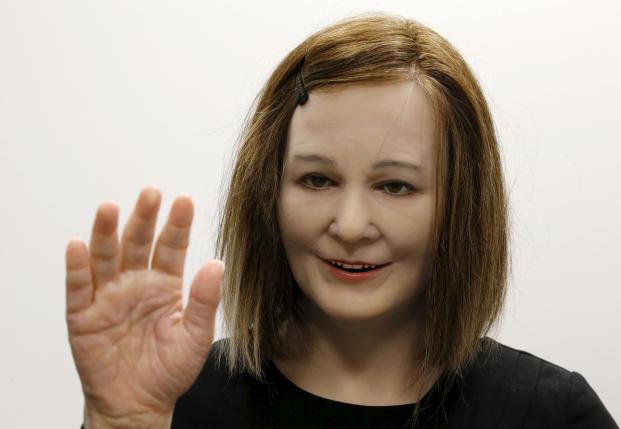
Nadine, a humanoid created by Nanyang Technological University’s (NTU) Professor Nadia Thalmann and her team, reacts to the presence of people during an interview with Reuters at their campus in Singapore March 1, 2016. REUTERS/Edgar Su
Nadine has short brown hair, soft skin and an expressive face. Nadine is not a woman; she is a new brand of human-like robot. Scientists are c that scientists are hoping that, one day, she will be used as a personal assistant or care provider for the elderly.
The 1.7-metre tall Nadine was created in the likeness of its maker, Nadia Thalmann, a visiting professor and director of Singapore’s Nanyang Technological University’s Institute of Media Innovation who has spent three decades researching into virtual humans.
Nadine enjoys software that allows it to express a variety of emotions and remember a previous conversation. Nadine is not commercially available, but Thalmann foresaw robots used as companions for people living with dementia one day.
“If you leave these people alone they will be going down very quickly. So these people need to always be in interaction,” Thalmann said, adding Nadine could provide conversation, tell a story or play a simple game.
Professor Thalmann said that the humanoid has her own personality and is capable of demonstrating positive and negative moods and emotions.
In a video of the robot in action, Nadia answers questions from her creator in a pseudo-emotional computerised Scottish accent.
‘You are a beautiful and attractive social robot,’ says Professor Thalmann.
To which Nadine replies: ‘Thank you. You look attractive too.’
The android can also react appropriately to negative sentiments.
For example, when Professor Thalmann says ‘I hate you’, Nadine replies excitedly: ‘Tell me more about that’.
Thalmann and her team are also working on emotive robots that can play with children. The project is still in the early development stage and no prototype is available yet.
According to Thalmann, the child robot would be able to respond to questions, display emotions and recognize people. The child robot can be a social companion while simultaneously supervising unattended children and informing a parent or nanny if something went wrong,
There are plans to program the child robot to speak different languages so that it can serve as an educational tool for children, she said.
“A child has toys but they are usually passive. This robot will be an active toy which interacts with the child,” said Thalmann. “It will be able to remember what the child likes.”
“Over the past four years, our team at NTU have been fostering cross-disciplinary research in social robotics technologies -involving engineering, computer science, linguistics, psychology and other fields – to transform a virtual human, from within a computer, into a physical being that is able to observe and interact with other humans,” Professor Thulmann added.
She added: “This is somewhat like a real companion that is always with you and conscious of what is happening.
“So in future, these socially intelligent robots could be like C-3PO, the iconic golden droid from Star Wars, with knowledge of language and etiquette.”
